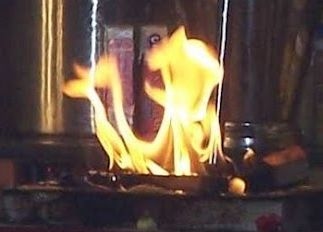Suppose someone who lived in a dark cave for his entire life comes out for the first time during mid day and sees Sun. Sun may feel unbearably fierce and cruel to that person. But, for someone else, the same sun is the giver of light, heat and life!
The state of consciousness represented by ugra devatas like Kali, Bhairavi, Chinnamasta etc is like the ultra-bright mid-day Sun. It is full of the light and illumination of Self. Most of us, normal human beings, are like someone who dwelled in a dark cave for the entire life, without any exposure to, or awareness of, such a pristine state of consciousness.
For one who has been confined to the pitch darkness of a physical body and limited mental notions of who one is and what one needs, the illumination of all-pervading Self is equally fierce and unbearable.
That is what their iconography captures!
Some deities have multiple iconographies. For example, there are several dhyanas of Ma Tara. Though most of them depict her as holding scissors and skull, other details vary.
For example, in one dhyana, she wears white clothes and shines brightly with the pleasant and soothing light of Moon. In another dhyana, she wears red clothes and is very energetic. In another dhyana, she is dark, scary and wears severed hands as clothes.
Akshbobhya (literally: unshakable or imperturbable) stands for the equanimity coming from non-distinction of the pleasant and the painful. His consort is Tara (literally: one who carries across). The energy associated with such equanimity does carry one across.
But that energy seems different to different seekers, based on their conditioning and undelying gunas.
If one is predominantly tamasik, the energy of equanimity that carries one across may seem very fierce and scary.
A predominantly rajasik seeker with much active practice may conceive the same energy as a passionate, energetic and mighty force that works powerfully to kill one’s weaknesses.
A predominantly saattwik seeker may view the same energy as a source of peace and calmness.
While the form for tamasik seekers holds sword also, which is used for large scale cutting off of undesirable qualities, this form for saattwik sadhakas holds only scissors and skull. Scissors are used for finer trimming and severing subtle nooses. Even a saattwik person is tied by the subtle noose of good character etc and some subtle attractions and aversions. The energy of equanimity that carries one across destroys I-sense (skull) and severs subtle nooses (scissors).
If one (or one’s guru) can honestly assess one’s gunas and one ends up using an appropriate form based on one’s nature, it will work better. The symbolism of an iconography does work on parts of one’s mind that one is not conscious of. The same mantra may work better when a better form is visualized.

